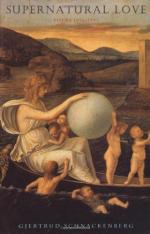|
This section contains 697 words (approx. 2 pages at 400 words per page) |

|
Variations in Rhyme
The poem is written in tercets, which are stanzas of three lines that contain a single rhyme. In other words, the endings of all three lines rhyme. In stanza 1, for example, dictionary-stand, understand, and hand all rhyme; in stanza 2, lens, suspends, and bends all rhyme; and so on. In some stanzas, the rhymes are approximate rather than exact, and these are known as off rhymes, near rhymes, or imperfect rhymes. Stanza 10, ending with because, messages, and does, is an example in which the vowel sounds are different in each word.
Stanza 11 contains an example of what is called eye rhyme, in which the endings of words are spelled the same and thus look as if they rhyme, but they are pronounced differently. These words are move, love, and clove. In stanza 15, all three lines end in the word nail, an example of what is called identical...
|
This section contains 697 words (approx. 2 pages at 400 words per page) |

|




